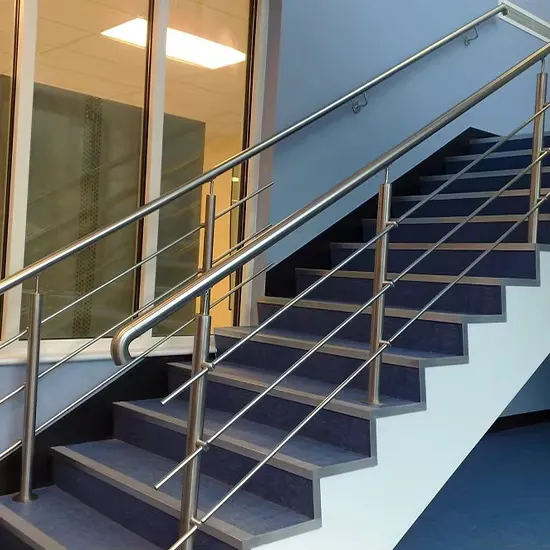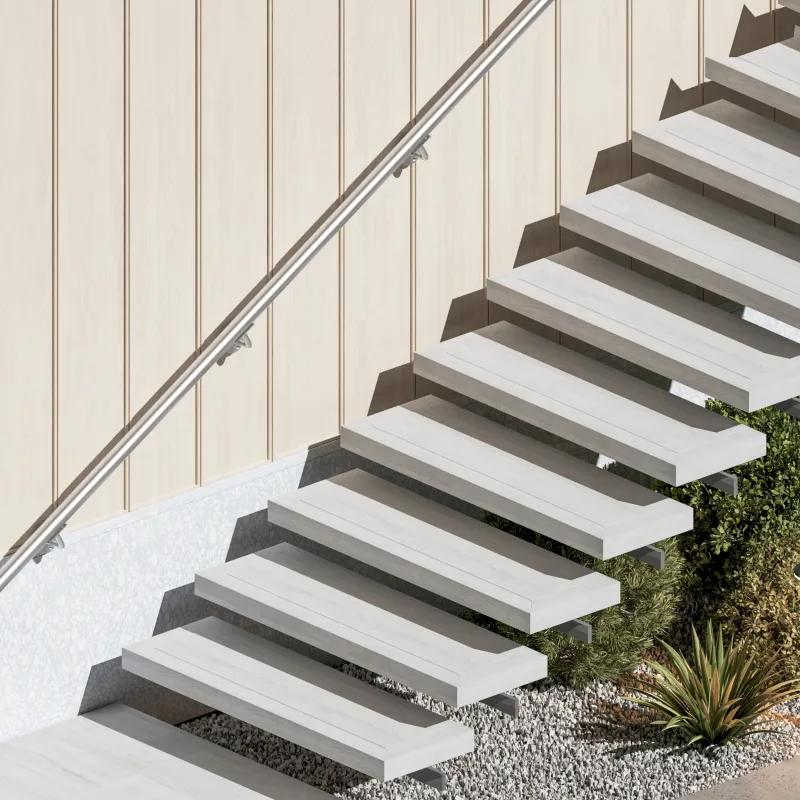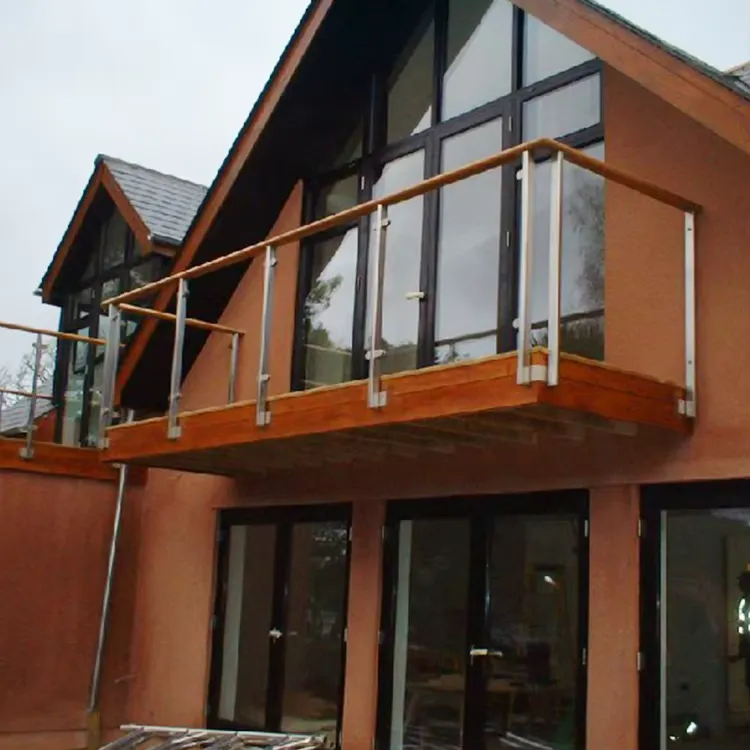If your railing rusts, wobbles, or blocks the view, it becomes a problem. Costs rise, cleaning drags on, and designs date fast. The solution is stainless steel—strong, sleek, and low maintenance—for railings that last and look right.
Stainless steel railings deliver durability, corrosion resistance, low maintenance, safety, and a sleek, unobstructed view. Cable railing options add modern design and airflow, while 304 and 316 grades fit indoor and outdoor spaces. They’re cost-effective over time for residential and commercial projects.
Stainless steel is highly known for durability and corrosion resistance. In a railing system, that means everyday bumps, cleaning, and weather do less damage. The metal’s passive chromium layer helps railings remain in pristine condition for years. Compared to other materials, stainless steel railings provide dependable strength and a sleek surface that resists staining.
For indoor and outdoor applications, stainless steel handles humidity and temperature swings. Railings typically face hand oils, cleaners, and rain; stainless steel is one of the materials to use that require minimal upkeep. With simple cleaning and maintenance, your stainless steel railing systems keep their visual appeal without repainting or sealing.

Why are stainless steel railings a durable, low maintenance choice?
A stainless steel cable railing uses stainless steel cables as infill instead of pickets or panels. The cable is tensioned between posts for a clean, unobstructed view. On decks, stairs, and a balcony, cable makes spaces feel open and modern while still meeting building code when designed correctly.
Choose cable railing where airflow, safety, and an unobstructed view matter—residential and commercial properties, coastal homes near the ocean, and rooftop patios. Stainless steel cable railings offer a sleek design that pairs with wood, steel materials, or glass railing. In short, stainless steel cable railing systems enhance sightlines and simple design.
See our stainless steel cable railing options for post kits, end fittings, and wire choices.
A well-placed handrail enhances the safety of a stairway and reduces slips for children or pets. Stainless steel handrails stay rigid under load thanks to excellent tensile strength. That strength helps railings provide reliable support on steps, ramps, and platforms.
From a design angle, stainless steel brings a sleek, modern design. Its aesthetic appeal fits many design styles, from minimalist to industrial. Because railings offer consistent finishes and profiles, they enhance the overall design without visual clutter.
Explore profiles and wall returns in our stainless steel handrails collection and code-compliant grips.

stainless steel handrails
304 and 316 are the popular choice for both residential and commercial stair railings and decks. 304 is widely available and cost-effective; 316 offers higher corrosion resistance, especially near the ocean. Consider stainless steel grades based on exposure and budget.
Below is a simple cost comparison and maintenance requirements guide. Prices vary by market and finish; the cost of stainless steel depends on thickness, polish, and the railing design.
| Grade | Corrosion resistance | Typical use | Relative material cost | Cleaning & maintenance |
|---|---|---|---|---|
| 304 | Strong corrosion resistance | Interior stair railings, covered decks | $$ | Wipe with mild soap; minimal maintenance |
| 316 | Higher corrosion resistance | Coastal, pools, harsh outdoor settings | $$$ | Similar cleaning; low maintenance requirements |
Material tips and tube specs: see 304 stainless tubing and rectangular stainless steel tubes for posts and top rails.
Yes. With steel cable infill or a glass railing panel, stainless steel frames keep lines thin so views stay unobstructed. Cable spacing and tension matter; follow building code and the manufacturer’s instructions so openings remain safe.
For a balcony or stair railings, the unobstructed view and airflow make spaces feel larger. When you use stainless steel posts and fittings, the result is a sleek and modern edge that doesn’t distract from the landscape.
For site-tested balcony layouts and hardware, visit stainless steel railings for balcony and browse glass and cable infill ideas.

Stainless Stair Railing for balcony
Think of aluminum and stainless steel as cousins. Benefits of aluminum include being lightweight and often cheaper upfront. Advantages of stainless steel include greater stiffness, scratch resistance, and a premium finish that complements high-end projects.
If railings are cost-effective over decades matters to you, compare total life cycle. Stainless steel costs more initially but can be cost-effective thanks to durability and longevity and low maintenance. Aluminum railings may dent more easily; stainless steel resists wear and stays pristine condition for years.
| Factor | Stainless steel | Aluminum |
|---|---|---|
| Strength & stiffness | High tensile strength; withstand heavy use | Moderate strength |
| Finish | Sleek, polished or brushed; aesthetically pleasing | Painted or anodized |
| Corrosion | Excellent corrosion resistance (esp. 316) | Good, but surface damage can expose base metal |
| Upfront cost | Higher | Lower |
| Life span | Long; durability and low maintenance | Good; may show wear sooner |
Most stainless steel railings require minimal cleaning—soap, water, and a soft cloth. For fingerprints, use glass cleaner. Avoid steel wool that can embed iron and cause surface corrosion. After installation, a quick wipe keeps the sleek finish bright.
Outdoors, rinse salt in coastal zones. Indoors, dust occasionally. Because stainless steel resists staining, cleaning and maintenance are simpler than with painted metals or wood. That’s part of the benefits of stainless steel ownership.
Over the long run, stainless steel railings are cost-effective. Less repainting, fewer replacements, and minimal downtime add up. When you consider stainless steel for a mixed-use building, you balance initial cost with the savings from fewer repairs.
Case study: A mid-rise with 800 meters of corridor railings chose stainless steel. Railings offer quick installation with modular posts and steel materials. After five years, maintenance requirements were a fraction of painted steel. The benefits of choosing stainless became clear in the total cost of ownership.
Material | Year-1 | Year-5 | Year-10 (Total)
-------------------|--------|--------|-----------------
Stainless steel | 100 | 120 | 150
Painted carbon | 75 | 160 | 250
Aluminum | 85 | 140 | 210
Numbers reflect a hypothetical index of purchase + upkeep; lower totals indicate fewer cleanings, repaints, and part replacements.
Pair stainless steel with a glass railing for a minimalist, sleek edge. If privacy matters, mix cable with frosted panels. The railing design can be a simple design with straight runs or a custom sweep for feature stairs that enhance entrances.
Because stainless steel finishes are consistent, they enhance lighting and stone, wood, or concrete. That aesthetic appeal helps new home design projects stay timeless across interior and exterior spaces.
Need curved elbows and smooth transitions? Check our stainless steel tube handrail parts for continuous runs.
Most codes require graspable handrail dimensions, height limits, and opening sizes that a 4-inch sphere cannot pass through. With proper post spacing and steel cable tension, stainless steel can meet building code and hold shape under load.
Thanks to tensile strength, fittings and posts withstand daily pushes and knocks in schools, transit hubs, and offices. That makes stainless steel a preferred choice for railings for your home and public spaces alike.
Stainless steel contains recycled content and is fully recyclable. It’s an environmentally friendly option that lasts longer, so fewer replacements are needed. That reduces waste and keeps finishes consistent across renovations.
Because stainless steel can be repolished, railings may be refreshed rather than replaced. The long life also means fewer disruptions where children or pets live or play.
As a professional stainless steel manufacturer and exporter, we help with take-offs, section choices, and fasteners. For OEM/ODM, we fabricate posts, top rails, and stainless steel cables to fit the overall design and stairway geometry. We also advise on indoor and outdoor finishes to match your interior and exterior palette.
From quoting to delivery, we standardize parts so railings are cost-effective to install. If you need custom elbows, hidden connectors, or ADA grips, consider stainless steel components tailored to your railing system and schedule.
Learn more about us as a stainless steel manufacturer in China and how we kit posts for stainless stair railings.
Precision matters. Use proper cutting wheels and deburr the edges of posts and top bars. Dry-fit assemblies, then protect surfaces with film during drilling and fastening. For cable terminations, match threads and ferrules to the wire diameter so tension holds over time without loosening.
When you plan the layout, keep post spacing consistent, confirm top rail continuity, and anchor into solid structure. Test the infill with a simple push gauge. Good planning reduces field fixes and keeps the finish free of scratches or swirls.
%benefits of stainless steel railings cable railing handrail
Openings that are too wide, posts spaced too far apart, or insufficient cable tension can cause failures. Verify engineering for spans, confirm fastener grades, and protect threads from galling during installation.
Another trap is mixing metals that react. Avoid attaching dissimilar fasteners that can cause staining. Instead, keep hardware grades compatible, isolate where needed, and follow manufacturer torque charts for a smooth, reliable install.
Tip: For consistent lines in large runs, choose pre-engineered kits that align with the railing system you’re building.
“We noticed fewer warranty calls once we standardized on cable infill. The system installs faster and keeps the lobby open to daylight.” — Facilities Manager, mixed-use tower
A coastal boardwalk needed to replace peeling painted rail products. The owner wanted an unobstructed view and fewer closures for repainting. The contractor proposed a post-and-wire system using 316 grade. The railing layout featured 1.5 m post spacing, concealed bases, and pre-swaged wire kits. Installers staged work at night to avoid beach traffic.
Results after two seasons: the posts and hardware showed no visible corrosion, cleaning took minutes, and the open design improved sightlines along busy crossings. The choice proved cost-effective because there was no repaint cycle, only quick rinses. The advantages of stainless steel cable infill—clean lines and airflow—also reduced wind loads on the boardwalk compared to solid panels. The city has since standardized on the same railing system for adjacent piers.
When you tally performance, stainless steel stands out: long life, clean looks, and simple care. It’s a popular choice for both residential towers and civic spaces. If you’re planning new stairs or decks, consider stainless steel parts that match your schedule and budget—then enjoy the view.
Are stainless steel railings hard to clean?
No. Most fingerprints wipe off with mild soap and water. For brightwork, use a microfiber cloth. Avoid harsh abrasives that could cause surface corrosion.
Will cable railing meet my local building code?
When designed and tensioned correctly, cable railing can comply. Spacing, end fittings, and post stiffness matter. Work with an experienced supplier to confirm details.
Is 304 enough outdoors, or do I need 316?
Use 304 in most inland settings. Choose 316 for higher corrosion resistance in coastal, pool, or chemical environments, especially near the ocean.
Do stainless steel railings fit traditional homes?
Yes. With round or rectangular profiles and brushed finishes, stainless steel can blend into classic millwork while providing modern performance.
What about price—are railings cost-effective?
Upfront cost is higher than some materials, but stainless steel often wins over time thanks to durability and low maintenance and fewer repaints.
Can I mix glass railing with cable?
Yes. Many projects combine stainless steel posts with glass railing panels and steel cable sections to balance privacy and an unobstructed view.
What Is 304 Stainless Steel Square Tube? Stainless Steel Square Tubing for Structural & Ornamental Use
What Is the Standard for Stainless Steel Tube? A Practical Guide to Stainless Steel Tubing, Pipe Specs, and Steel Tubes
What Are the Benefits of Stainless Steel Railings and Cable Railings?
Are Glass Staircases Safe? Railing & Stair Panel Safety